On the Road is a weekday feature spotlighting reader photo submissions.
From the exotic to the familiar, whether you’re traveling or in your own backyard, we would love to see the world through your eyes.
Happy Monday!
We have another great set of OTR posts for this week. Take a look at what’s ahead. (click to embigen)
Albatrossity
After a morning dodging raindrops at Ash Canyon Sanctuary, I headed to the Coronado National Memorial, a grassland and foothill-rich federal property on the US/Mexico border. I was hopeful, even though it was early afternoon, that I might catch sight of some of the iconic birds that can be found there.
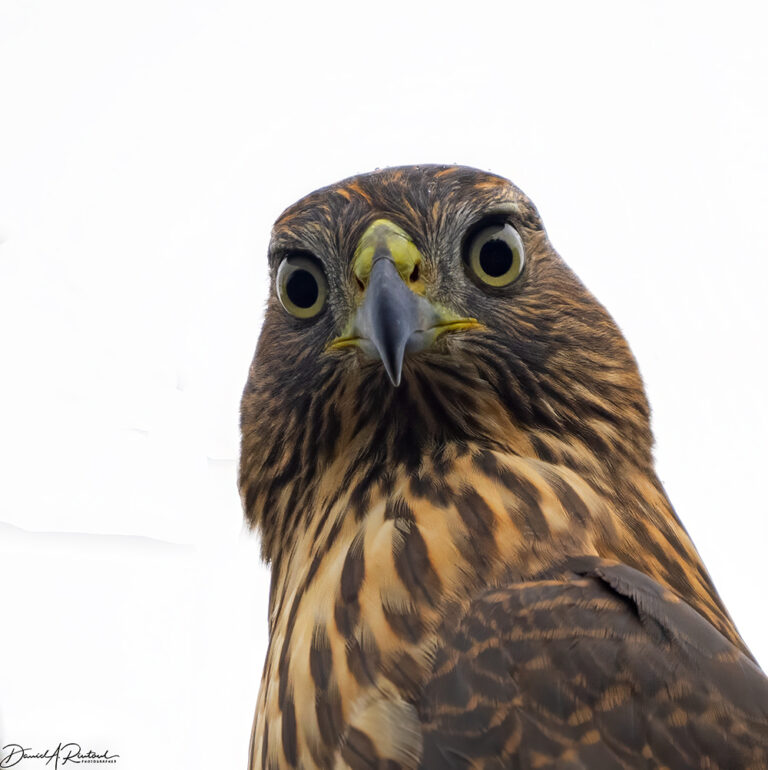
I didn’t find my target birds (Montezuma Quail and Vermilion Flycatcher), but I did find a pair of young Cooper’s Hawks (Accipiter cooperi), or rather, I should say, they found me while I was eating lunch at one of the streamside picnic areas near the headquarters. One of them flew in and landed on a dead snag near my table, and seemed to be sizing me up as a prospective meal. Another, probably its sibling, came along and also glared at me from an adjacent site. Cooper’s Hawks in these mountains seem pretty bold! Click here for larger image.
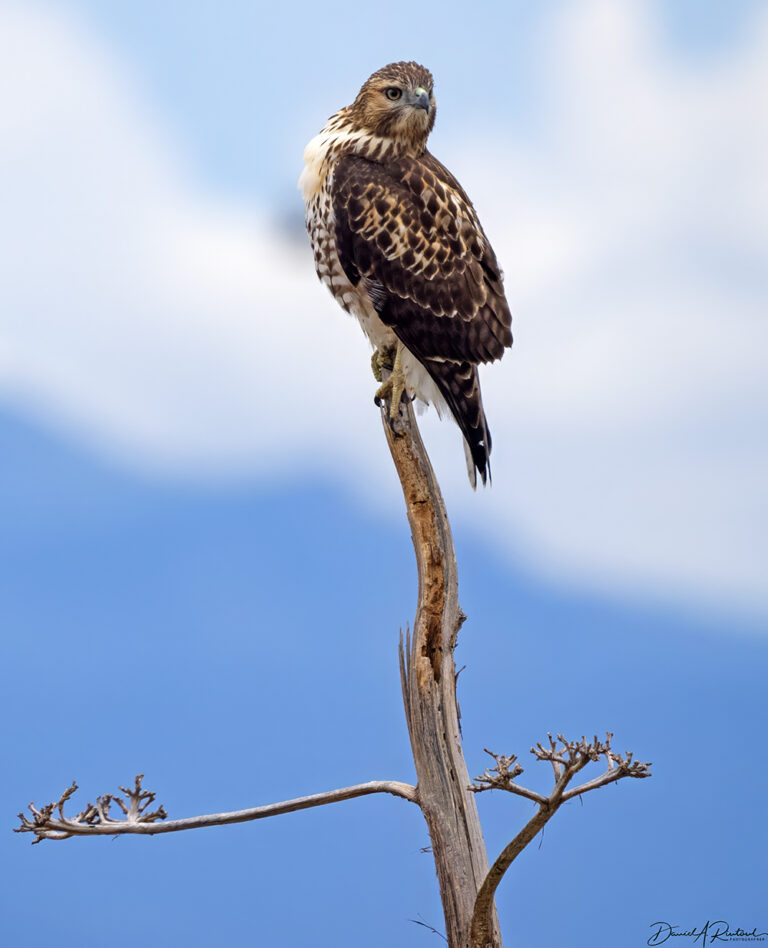
I also found a young Red-tailed Hawk of the western subspecies (Buteo jamaicensis calurus), which I don’t regularly see here in Flyover Country. So I spent some time watching and studying it, just in case I run across one here someday. Click here for larger image.
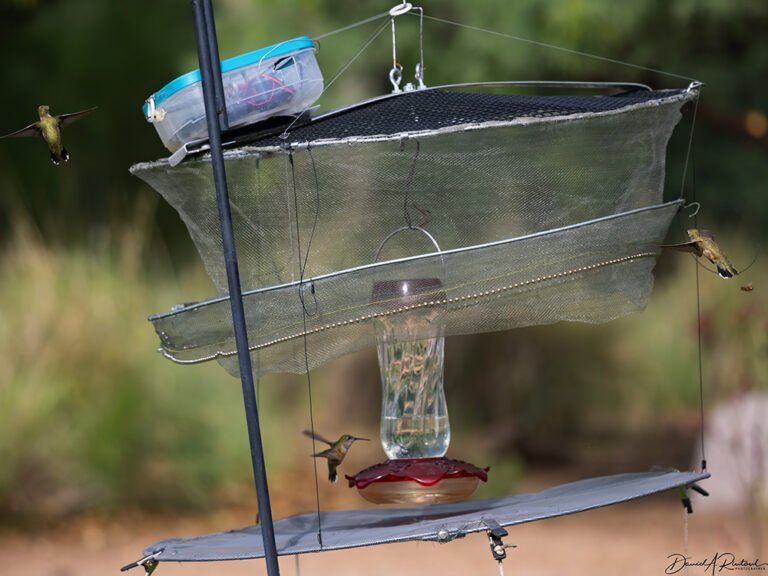
The afternoon of my first full day in SE Arizona was highlighted by a demonstration of how to catch and band and release hummingbirds, orchestrated by master bander Sheri Williamson and her husband Tom Wood. As you might imagine, fitting bird bands on these tiny-legged flighted jewels is not simple, nor is it something that anyone can do. There are fewer than 200 hummingbird banders in the country, and Sheri is one of the best and most productive of them all, having banded thousands of hummingbirds over the years. It was a blast, and well-attended by both humans and hummers.
The Casa de San Pedro, where I was staying, was the site of this demonstration. The Casa probably has 20 or 30 hummingbird feeders scattered throughout the property. In order to concentrate the birds at a feeder fitted with this trap, all of the other feeders were temporarily taken down. The trap consists of a cylindrical mesh net that fits over the feeder, and a floor where the net lands, sealing the birds inside the net. The Tupperware box on top of the net contains a remote-controlled trigger that drops the net once the triggerman (Tom) decides that the birds at the feeder include some that need to be caught and banded. Once the net is dropped, a crew of bird grabbers and transporters descends and retrieves birds from under the net, places them in their own mesh carrying cases, and delivers them to the banding table where Sheri examines them, ages and sexes them, bands them, and then hands them off to be released by some of the onlookers. Click here for larger image.
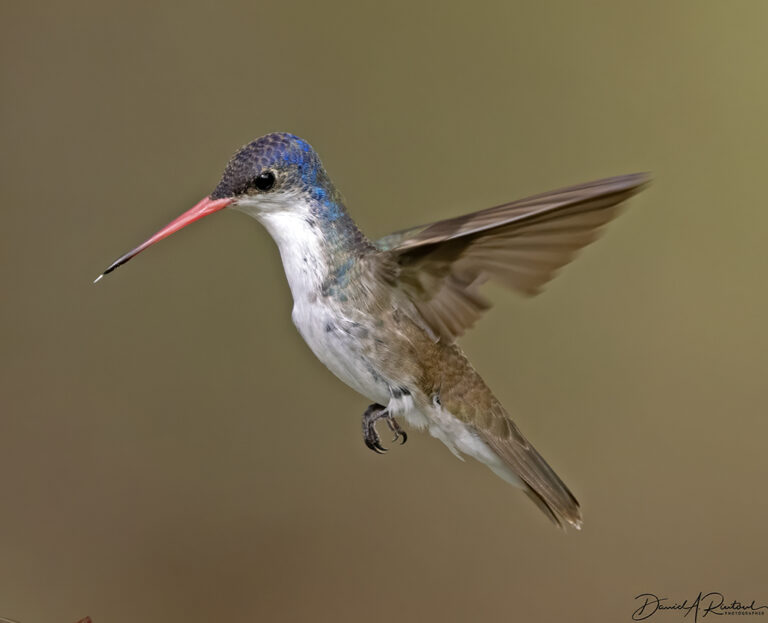
Over the course of the next two hours, 28 hummingbirds were trapped, banded, and released. One of them was a Violet-crowned Hummingbird (Leucolia violiceps), which has been expanding its range northward from Mexico in recent years. At another banding demonstration the previous week, one of these was captured and banded, so when this one was captured, we wondered if it was a recapture of the previous week’s bird. But no, it was unbanded, so there were at least two of these beauties at the Casa this year. Click here for larger image.
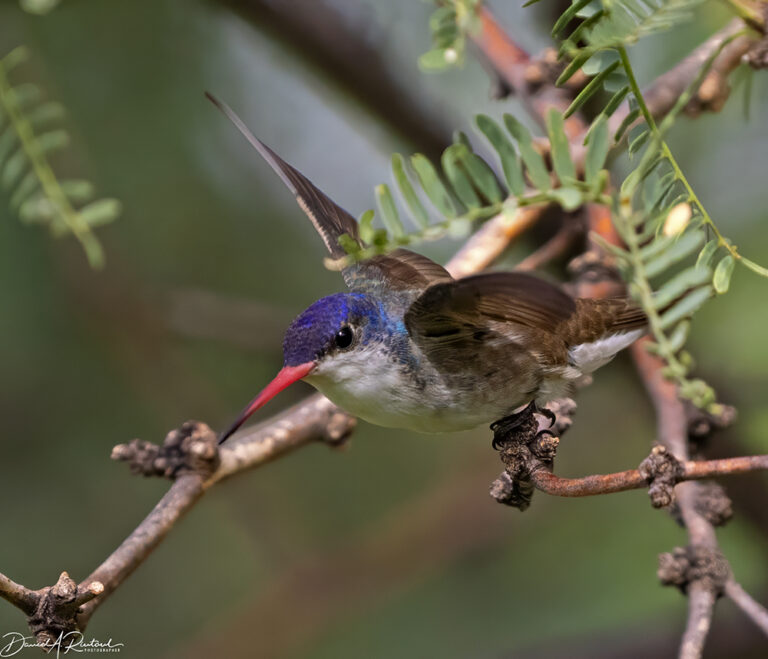
Here’s another shot of a Violet-crowned Hummingbird, perched in a mesquite tree near the feeder and the trap. This one never got into the trap zone, so perhaps it was the previously-banded bird. Or perhaps it was yet another! Click here for larger image.
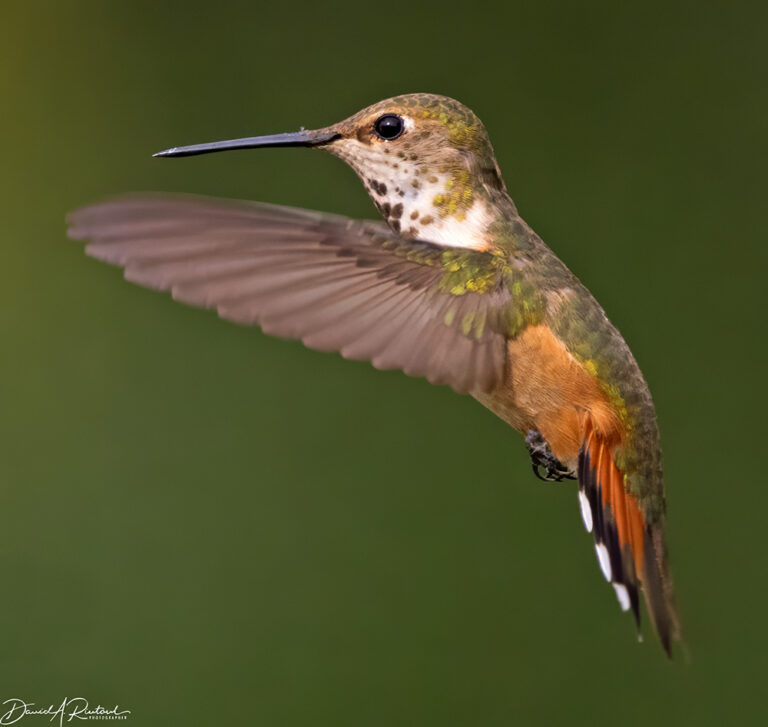
Another common species at the Casa this year was the Rufous Hummingbird (Selasphorus rufus). This is an adult female, not as flashy as the adult males, but a beauty in her own way. Sheri banded 10 of these (6 juvenile males, 1 juvenile female, 1 adult male, and 1 adult female, perhaps this bird). Click here for larger image.
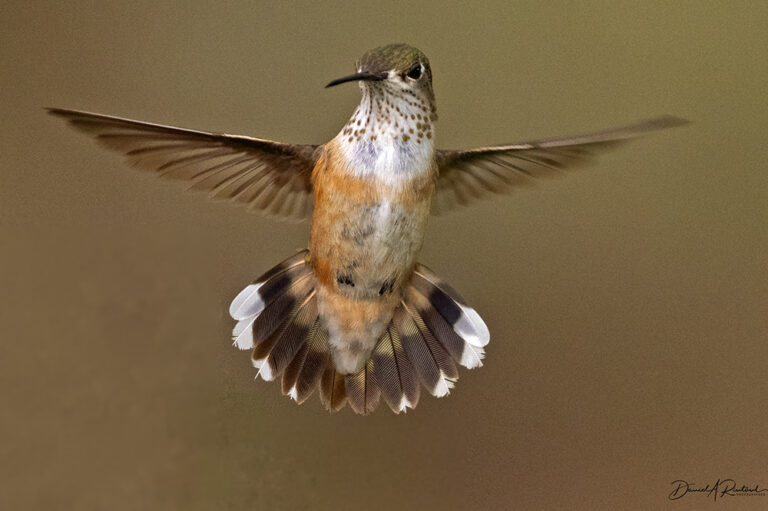
A less common species, but highly sought by birders, this is a young male Calliope Hummingbird (Selasphorus calliope). Two were banded that afternoon, one adult female and one juvenile male, perhaps this one. This short-tailed and short-billed hummingbird is the smallest of all North American breeding birds, it weighs in at a mind-boggling tenth of an ounce (2.5-3.5 gm), but it packs a lot of pugnacity in that tiny body. Click here for larger image.
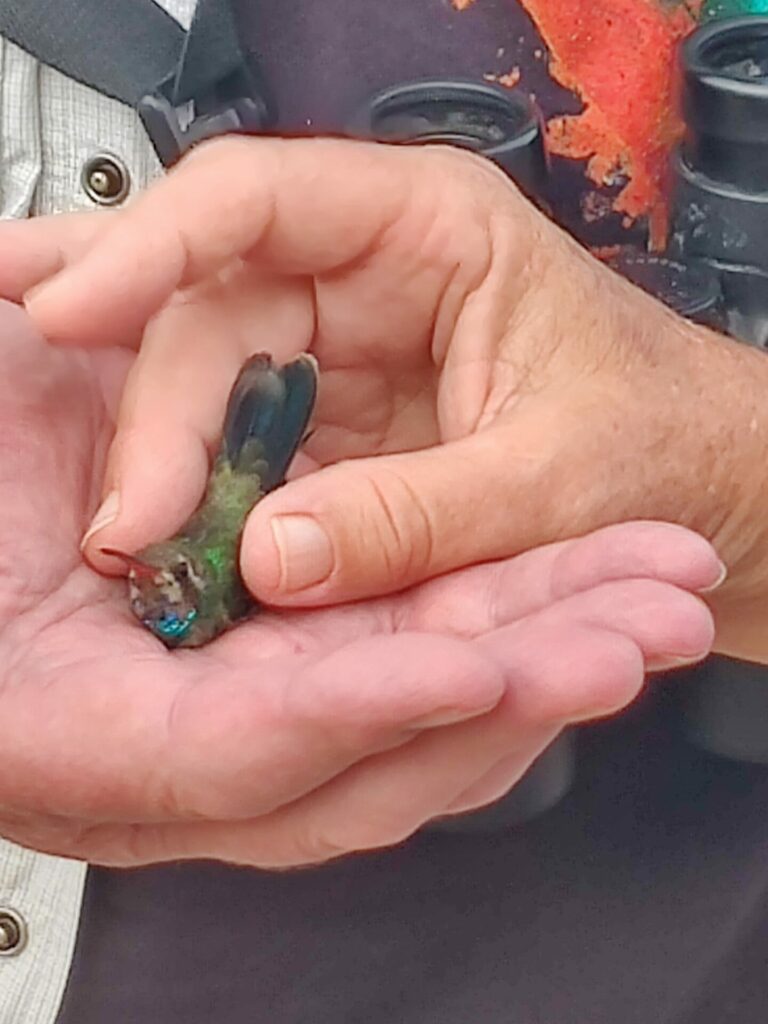
At the end of the day, when lots of onlookers had been able to watch and then to hold and release a newly-banded hummingbird, I was offered the opportunity to be the takeoff platform for this young Broad-billed Hummingbird (5 were banded that afternoon, and I learned that these ae known as Bill in the local vernacular). After the band is attached, the bird is offered some sugar water to help it recover from the time and vexation of the banding process, and then placed on the open palm of a willing volunteer. Here’s a video of Bill taking off from my hand. My fashionable outfit consists of baggy cargo pants, a t-shirt designed and gifted to me by my daughter, a permethrin-impregnated long-sleeve shirt to discourage biting insects, and a cap from the gift shop at the North Rim of the Grand Canyon. Follow me for more fashion tips. Click here for larger image.

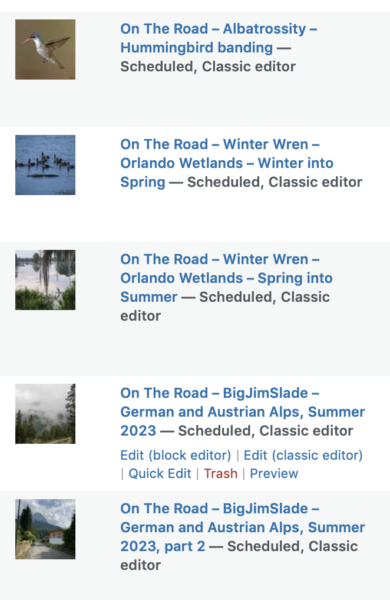
JPL
What an amazing experience and thank you for sharing the pictures and the video with us.
eclare
Fascinating. It must have felt great to be a launching pad!
OzarkHillbilly
Hummers!
Love that red tailed hawk on the staub pic.
HinTN
“Go have a margarita.” A great sendoff. 😎
J.
Great photos, as usual. Particularly love the first one.
mrmoshpotato
Very very cool.
Also, Hawks being the opening band for Hummingbirds – oh yes.
sab
@OzarkHillbilly: I came home a couple of days ago and there was a red-tailed hawk chomping on a late lamented squirrel. Those hawks are big birds.
Then that very same day our newest, smallest cat shot out the front door and spent 4 hours lurking outside in the neighborhood. I was so relieved when she turned up on the doorstep wanting dinner.
She wanted to catch some birds. I was afraid some birds (or coyotes) would catch her.
ETA Coopers Hawks in the wild live 20 years, Redtailed live 25 years. They all are way more experienced than my two year old cat hunting sparrows and chipmuncks. Yikes that she was outside at all.
AM in NC
I just want to let you know how much I love your posts. I learn so much, and they make me feel good to start the day, lowering my blood pressure after having it raised by all the politics-oriented posts (which I also love, but they are generally not calming). I just started being interested in birds last year as I was caring for my mom at the end of her life. SHE was interested in birds, and sparked my interest. Thank you!
Betty Cracker
What a great description: “tiny-legged flighted jewels.” The bands must be incredibly tiny. Also, you make a terrific launching pad — well done! ;-)
sab
@sab: She is a small cat, only 8 pounds. We have been trying to plump her up, but however much she eats she is a small cat. Two months with us and she hasn’t gained an ounce. She is what she is, small.
Albatrossity
Thanks, all. I’m glad you enjoy the posts, and yes, it is a great feeling to be the launching pad for one of these feisty gems. I would hate to mess with one that had gotten into the margaritas!
Here is some more information about the banding process, and if you are interested in doing this some day, there are still 4 banding demonstrations this fall (see the sidebar on the link above), and there will be more next year, starting in early August per usual, I presume.
sab
When I lived in Las Vegas NV we had a hawthorn tree that hummers nested on. One year I cannot remember what I was doing, but the hummer mom landed on my finger for a bit. I was struck rigid. It was magical. Then she got bored and flew away.
Betty
I am trying to imagine how you first learn to band those tiny legs without damaging them. We all too frequently have hummingbirds that get trapped inside our house. We have to wait until they tire out before we can catch them, give them their sugar water and send them on their way. Amazing and beautiful little critters. Everyone now and then we lose one who stays out of reach too long. Really sad.
eclare
@sab:
Def keep the kitty inside!
SteveinPHX
Thank you! I just got back from a few days in SE AZ. Added a new warbler to my list plus a couple other birds. Had a wonderful time!
Now back to the day job.
Your photos just blow me away!
sab
@eclare: We didn’t know she wanted out. We have five cats, and four of them and all their predecessors were committed indoor cats.
eclare
@sab:
I have one cat, and I would love to keep her indoors full time, but her prior owners let her out, and she likes it. Now she is sneaky about it: when I come in with groceries she sneaks out, when I let the dog out she sneaks out, etc.
Kabecoo
Probably not going to follow you for more fashion tips, except for the tshirt!
StringOnAStick
Your obvious joy as that Bill flew from your hand made my day!
TheOtherHank
A few years ago I pointed my GoPro at my hummingbird feeder and shot a bunch of slow motion videos of the local birds feeding. Here’s one of them: https://youtu.be/QwltxG_zoNU?si=SYUjVj165SMhmh4R
Betty Cracker
@sab: There really is something magical about encountering the hummers. I have a couple of feeders on the side porch, and sometimes when I’m standing by the railing, they’ll fly right up in my face and hover there, seeming to check me out. It’s the coolest thing!
Albatrossity
@Kabecoo: I’m crushed that you don’t appreciate my bold fashion sensibilities ;-)
But the shirt is unique, or, as the kids say today,. bespoke. My daughter painted that portrait of a European Kingfisher while she was doing a postdoc in Germany, and it appeared on this shirt as a Christmas present a couple of years ago. It’s definitely one of my favorites!
way2blue
Albatrossity. With respect to your first photo. Thanks but no thanks! Yo.
mvr
These are all great photos and the accompanying information is really cool as well!
Thanks!